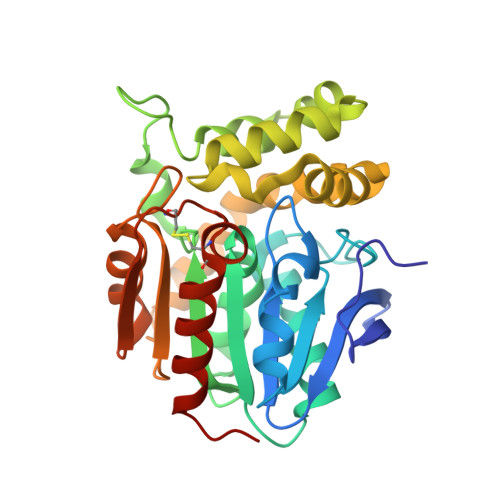Active-Site Flexibility and Substrate Specificity in a Bacterial Virulence Factor: Crystallographic Snapshots of an Epoxide Hydrolase.
Hvorecny, K.L., Bahl, C.D., Kitamura, S., Lee, K.S.S., Hammock, B.D., Morisseau, C., Madden, D.R.(2017) Structure 25: 697-707.e4
- PubMed: 28392259
- DOI: https://doi.org/10.1016/j.str.2017.03.002
- Primary Citation of Related Structures:
5TND, 5TNE, 5TNF, 5TNG, 5TNH, 5TNI, 5TNJ, 5TNK, 5TNL, 5TNM, 5TNN, 5TNP, 5TNQ, 5TNR, 5TNS - PubMed Abstract:
Pseudomonas aeruginosa secretes an epoxide hydrolase with catalytic activity that triggers degradation of the cystic fibrosis transmembrane conductance regulator (CFTR) and perturbs other host defense networks. Targets of this CFTR inhibitory factor (Cif) are largely unknown, but include an epoxy-fatty acid. In this class of signaling molecules, chirality can be an important determinant of physiological output and potency. Here we explore the active-site chemistry of this two-step α/β-hydrolase and its implications for an emerging class of virulence enzymes. In combination with hydrolysis data, crystal structures of 15 trapped hydroxyalkyl-enzyme intermediates reveal the stereochemical basis of Cif's substrate specificity, as well as its regioisomeric and enantiomeric preferences. The structures also reveal distinct sets of conformational changes that enable the active site to expand dramatically in two directions, accommodating a surprising array of potential physiological epoxide targets. These new substrates may contribute to Cif's diverse effects in vivo, and thus to the success of P. aeruginosa and other pathogens during infection.
Organizational Affiliation:
Department of Biochemistry and Cell Biology, Geisel School of Medicine, Dartmouth College, Hanover, NH 03755, USA.















